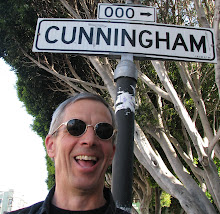A couple of weeks ago I was on a panel of men speaking at the TSA Symposium in Los Angeles, discussing something called "The Male Mystique." The other men on the panel were intimidatingly well qualified for this, and I enjoyed seeing their work, hearing their views. But the real reason to be at the TSA Symposium was to attend other lectures and to learn about things I never imagined.
Like the picture above, taken during a lecture on central Asian textiles. It shows an "Ink Painted Wool Tapestry...woven by the Mongours, a Chinese minority living along the Yellow River during the Yuan Dynasty (1279-1368)...(who) practiced a religion called Manichaeanism after its founder Mani, who was born in Babylonia and lived in third century Persia...(they) believe that the universe is divided between the forces of Good, exemplified by light, and the forces of Evil, demonstrated by Dark..."
I hardly know where to start. Let's start with the idea that this is nearly a thousand years old, and its design looks like something from mid-20th century Europe. Or how about the idea that the design vocabulary is only vaguely Chinese, which you can see in the little curlicues in the cloudlike formations, but that the peacocks in the foreground come from somewhere with which I am unfamiliar. Then the alternating bands of dark and light, or Dark and Light, which yet do not strictly alternate in a symmetrical way, but seem to be intertwined.
For me it is positively thrilling to see something like this, to encounter a civilization I never knew existed. And who is Mani? What does the rest of their art look like?
This is why it is worth all the travel and expense to attend one of these conferences. The people who are doing the deep study will share it with you and open your eyes to new worlds.


No comments:
Post a Comment